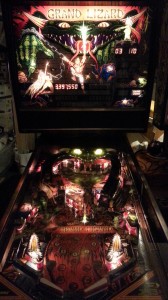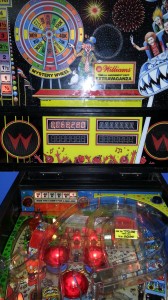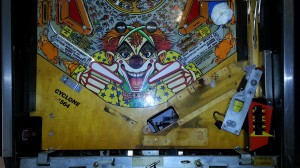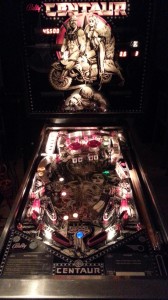Selling a pinball machine is often a long distance interaction, which requires using the Internet to exchange photos and videos of your machine, and usually a few good phone calls to close the deal. In some cases you will have the machine shipped away using a reputable carrier such as NAVL, in which case you’ll need to be home for the pickup, and you’ll just want the machine ready with keys and balls in a ziplock bag taped to the coin box inside the machine, with the head down — the shipping company will do the rest by wrapping the game in plastic, and putting cardboard protectors around the corners of the machine. In other cases, you’ll be greeted by someone who drove across the state line 5-10 hours to obtain your pinball machine. There will be always be a few local tires kickers and flippers who come look quickly when you place the ad — they’ll travel up to 30-45 minutes to your home to come look at the machine but we never know if they are truly interested in buying or even paying your asking price. As you can imagine, people will have a range of expectations (from none, to many) about knowing the condition of your machine before investing the time to communicate with you or travel to view the machine. The goal is to honor everyone’s time and meet expectations. The long distance buyer tends to be a much more serious buyer, since he is taking the most risk. He is having to factor in using NAVL for ($300-$500 extra) who might damage the machine in transit either by damaging the body directly, or by simply rattling loose some component that causes the machine to not work upon arrival. Neither party wants to have expectations unmet, and neither party wants to engage in any sort of refund scenario later on. This guide is to help ensure that both parties are very happy with the transaction, and to make it as short of a process as possible for both parties.
In the summer of 2013, I have now purchased 8 machines and only in 1 case was the seller within a 20 minute drive where I didn’t “ask” 20+ questions up front. All 8 purchases have met or exceeded my expectations, and that is due to asking the right questions up front, and working with the right sellers. I have never bought a machine from a seller that even hinted at hesitating to provide full disclosure on his machine. That should be the seller’s #1 goal. Regardless of the many flaws in your machine, your goal as the seller is to share ALL flaws with the potential buyer ASAP up front. The process can be time consuming if you do it all by phone, so your job is to take the right set of pictures and movies, and disclose all the perks and flaws of the machine (one time), so that you minimize your time discussing the same facts over and over by email or phone. You automate the sale with a GREAT ad on Craigslist or ebay. By creating a great ad, you win his trust quickly, and he’s more likely to buy from you right now. The more you dance around the flaws of your machine, the more fishy you sound, and then you are setting up the transaction for unmet expectations down the road, which just wastes everyone’s time. Take a couple hours early in the process, and present your machine really well on CL or ebay, and save dozens of hours down the road in re-selling the same points and dancing around flaws over and over. In 2013 with the economy slowly recovering, and machines becoming ever more scarce, it’s a seller’s market. With a great ad, and a good price, you’ll have plenty of potential buyers, and you can pick the right buyer that won’t waste your time.
The following checklist is designed to help you win the confidence of the long distance buyer, who will be expecting more information up front than the local tire-kicker who can just drive over quickly, take a look, play your machine for fun, and then drive home with no real intent to buy.
Seller’s Checklist
Photos (1-31)
Prepare 31 pictures of the following: (300K – 2MB per pic). Zip them up and be ready to share them with the next potential buyer. Alternatively, you can host them as a gallery on photoucket.com or flickr.com. Craigslist allows for 8 pictures, so you’ll want to include one from each of eight sections below, and then you can send the .zip set one-by-one with each email or call received, or you can simply link to your photobucket/flickr account and save both parties time. By including one photo of each in your ad, you are demonstrating right off the bat that you are a savvy seller that intends to offer full disclosure to the best of your ability up front.
1-2) Backglass: Remove the backglass, and photograph the front in a well lit room, then flip it around, and take a shot of the grey backside from a low angle to show smoothness or cracks/lifting in the artwork
3-6) Circuit boards: Take a close up shot of each circuit board and the battery pack. (note: don’t use a flash for these shots!)
7-12) Playfield: Take some playfield pictures with glass off. It is most important to show the wear (or lack of wear) around the lower flippers, and an extreme close up of the entrance to each ramp or any place where a ball is dropped from a ramp or habitrail wireform.
13-15) Playfield wear spots: Show any spots on the playfield or plastics that you think may be an issue for the buyer.
16) Coin box: Take a shot of the Coin box.
17-21) Body: Take a shot of the left backbox, left body, right back box, right body, and rear of backbox.
22) Toys: Take a close up of any hard-to-find plastic toys in the game.
23-25) Inlanes + Flipper Area: Take pics of both left and right inlane areas and in front of the flippers — this is where a lot of wear happens.
26-30) Underneath the playfield, both the underside and inside the box.
31) Insert shot. Take a shot with the lights off, and let us see how much light is bleeding through the inserts. (This is possibly the most important shot to me, since I play with the lights off.) I stood on a milk crate 1 foot off the ground to take this shot, and put the machine on diagnostic mode: “all lamps”.
DESCRIPTION
Do not copy/paste the ipdb.org’s long description of the game here. Instead, just include the information you would be sharing in person. Instead of focusing on how fun you think the machine is, focus on offering full disclosure about every aspect of the machine in writing.
Declare the following in writing in your ad: (in the spirit of full disclosure.)
- Accessories: Are you including the original manual? A key ring? Any other goodies?
- Backbox: Are there any heavily scratched spots or missing pieces of wood?
- Backglass Art: Any bubbling of the art? Any flaking? Any cracks? Any missing art?
- Batteries: Have you inspected the batteries for corrosion? Have you replaced them recently?
- Body/Coindoor: How is the artwork? How bad are the scuffs on the side? Any chips of wood missing?
- Display: Is the score display working well for all 4 players? Is it original or a low-power LED from pinscore/rottendog?
- Keys: Do you have keys for the backbox and coin door? Do they both work?
- Parts: Are there any parts missing? Have you replaced any parts? Are you including any extra parts?
- Playfield Art: What is the general condition of the playfield? Any missing art? Any noticeable scuffs? (please try to show the wear spots with your pictures.)
- Playfield Mylar: Please describe WHERE the mylar currently is and is not on the playfield.
- Playfield Touchups: Did you or did a previous owner make any paint touch-ups?
- Repairs: Does anything need any work at this time? What work have you had done on it?
- Upgrades: Have you added any interesting mods to the machine?
PAYMENT/SHIPPING
Let your potential customers know if you’ll accept delivery by NAVL or other shipping companies. Also make clear your payment terms for in-person and long-distance purchases.
Videos
The following two videos are 2-3 minutes in length and when shot in 720HD, they are roughly 100MB in length. This is too large of a file to share via email, so you’ll want to take 5 minutes and make a youtube.com or vimeo.com account if you don’t already have one, and host the files there. When the machine is sold, you can remove the videos and close the account if you wish.
1. Show a video of the ball action:
- Take a short two-minute video, to show how flat and smooth the playfield is. If you remove the glass, and allow the ball to slowly and gracefully roll from several points on the table down to the flippers and slingshots with the power off, we can get a sense of how smooth/flat the playfield is. If you use low resolution then you won’t create a massive file — aim for a 5mb file max. If you put the camera at the flipper’s point of view, or a low point of view, that ball trajectories can be observed. This is what I would do if I were able to visit in person.
2. Play the game for us:
- Take a second two-five minute video, and allow the buyer to get a sense of the lighting, sounds, and action. This is where you really sell the game. If you find the game plays slowly, or if the ball tends to lean left or right — make sure the playfield is level, and pitched at 6′ to 6.5′ — you may need someone to help you level the machine and get the pitch right, while you adjust the leg levelers touching the floor. While slings and flippers are easy to repair and tune up, it’s still a good idea to show off how well your machine plays.
Diagnostic Tests
- Run diagnostics on each component (music/display/lamps/switches) to make sure everything is working right (Open the coin door, hold the red button down, and click the black button closest to the hinge, then release the red button), cycle through all tests with the black button. You have to manually do the switch test by hand with glass off and manually click each switch with your hand. During the coil test, you press the red button down to get each item to repeat itself repetitively.
- Can you now comfortably run through all the tests one by one and verify that every display cell/coil/lamp/flasher/switch/sound works? Do the diagnostic tests give you any useful information?




